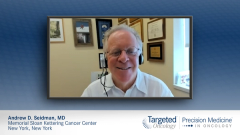
CIN Prophylaxis in Solid Tumors
Considerations for treatment selection for chemotherapy-induced neutropenia.
Episodes in this series

Joyce O’Shaughnessy, MD: I was just reflecting on how the NCCN [National Comprehensive Cancer Network] recently has expanded its support on the guidelines for the use of prophylactic agents to prevent CIN [chemotherapy-induced neutropenia] for therapies that have a 10% to 20% risk of febrile neutropenia. That’s been strongly reinforced in the context of COVID-19, which unfortunately, is still very much with us. When you look at the NCCN Guidelines, they’re very clear and helpful. They have lists of single agents and regimens that, across all cancers, are associated with more than the 10% to 20% [febrile neutropenia risk]. And it’s a long list. It’s like every [therapy] I use every day. It’s AC [doxorubicin hydrochloride, cyclophosphamide]. It’s AC [doxorubicin hydrochloride, cyclophosphamide] followed by T [docetaxel], the dose dense. It’s TCH [docetaxel, carboplatin, trastuzumab]. It’s ACTH [doxorubicin hydrochloride, cyclophosphamide, paclitaxel, trastuzumab]. It’s TCHP [trastuzumab, pertuzumab]. It’s TC [docetaxel, carboplatin]. Everything I use is on that list, certainly in the curative setting. But it’s super helpful for docs who are trying to understand that risk for CIN, and where do the guidelines support the use of hematopoietic growth factors. The NCCN is super helpful in that regard.
Andrew D. Seidman, MD: I agree. Not just regimens—we’re also thinking about the patient and what data we might have about risk factors for the use of myelosuppression. Joyce, I’m wondering, do you consider older patients to be at greater risk? Do they have to be octogenarians for you to start to get worried? Are there other variables, such as radiotherapy to marrow-bearing bone, or nutritional issues, which impact your threshold?
Joyce O’Shaughnessy, MD: My gosh. It’s lots of stuff, isn’t it, Andy? This is 1 of those things you have a feel for, but the age issue was really critical. I remember the early days of trials around hematopoietic growth factors, and over 65 years of age was the threshold for really increased risk. As you know, it’s all cycle 1, isn’t it? When you’re going to use a myelosuppressive regimen, cycle run is the highest risk. So you can’t wait. You can’t give the 70-year-old patient a dose of myelosuppressive therapy and say, “Let’s see what happens in cycle 1.” It’s the cycle 1 that’s the most vulnerable for the patients. That’s a risk factor, for sure, [being] over 65.
Another 1 that’s important is the extent of liver metastasis, liver function, because obviously the liver is so important for metabolizing our agents. It’s very difficult sometimes in the context of substantial liver metastasis to get the doses right for the patient. We’re putting them at significant risk for very serious myelosuppression. Albumin is a very good marker generally of overall tissue integrity and the patient’s reserve. It goes so closely with the performance status, etc. These are very important. I worry about patients who get polypharmacy. There’s so much we don’t know about drug interactions, and these are metabolized with CYP3A4. Oftentimes so many things interfere with CYP3A4. Those are some top-of-mind ones, Andy. Is there anything I’ve forgotten?
Andrew D. Seidman, MD: Those all resonate for me. Thinking also about daily filgrastim injections, patient compliance with that was sometimes something to worry about, and confusion about the number of days. Then there’s the whole other issue of how often do you check CBC [complete blood count] if you’re giving docetaxel and you’re planning to give it every 3 weeks? Are all physicians checking day 8 and day 15 neutrophil counts, or are you just telling them to come back in 3 weeks and waiting for an event to occur? There’s a lot of heterogeneity out there.
Joyce O’Shaughnessy, MD: Right, and that speaks to risk, because if it’s very complicated to try to manage this, that puts people at risk because it’s difficult for people to get in [to see their provider]. Sometimes people can’t self-administer; they can’t do it themselves. But they have to get into the office multiple times. It’s something that isn’t feasible for the GCSF—the filgrastim, not with the pegfilgrastim.
Andrew D. Seidman, MD: I remember learning that before you give myelosuppressive chemotherapy, you should send your patient to the dentist for a good dental exam and cleaning. I have to confess that’s not my standard practice unless there’s some obvious signal that’s telling me to deal with it. But even a very short period of deep neutropenia in somebody who’s got some smoldering dental abscess could end up needing hospitalization.
Transcript edited for clarity.













































